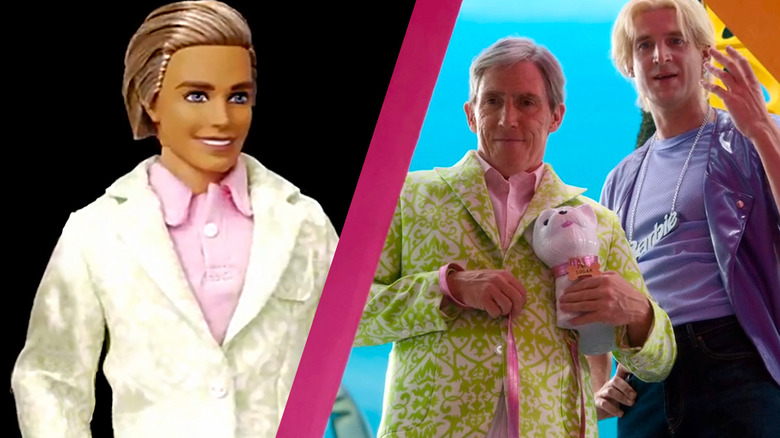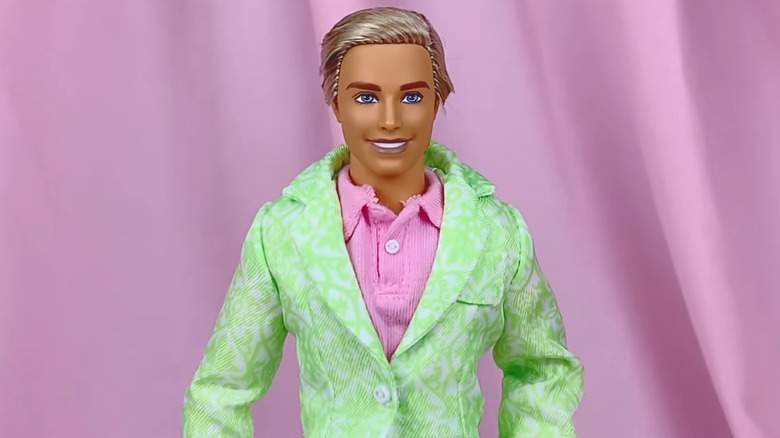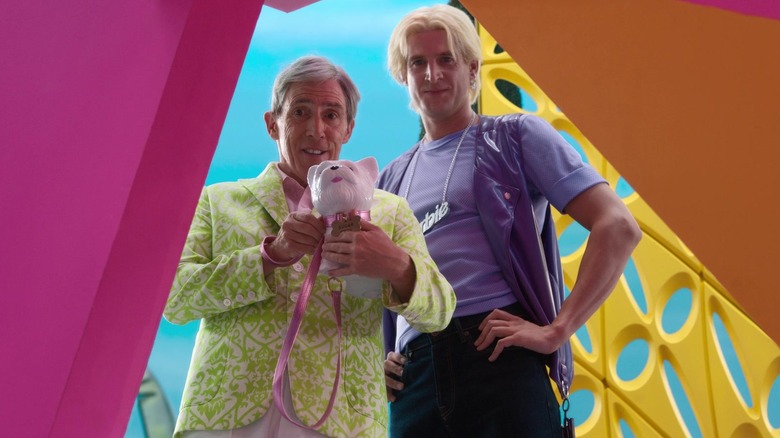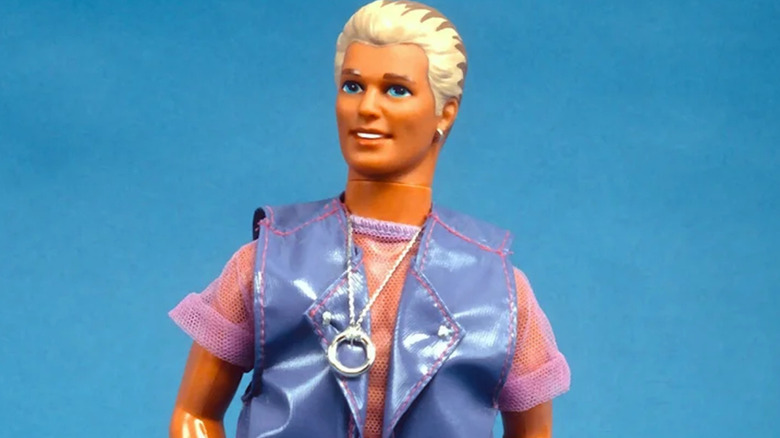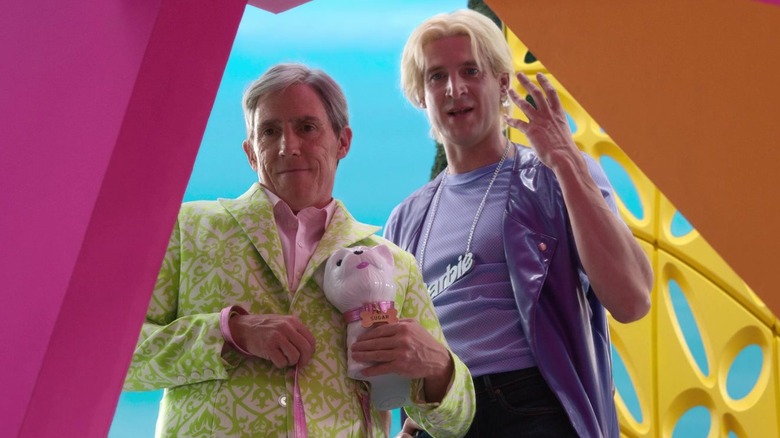Is Sugar Daddy Ken Barbie's Most Controversial Ken? Not Compared To His 'Cocky' Bro
Barbie may be a beloved brand among generations of people, but it also has a long history of breeding controversy. Not every mom wants their daughter to emulate a teenage fashion model, after all — not even if she grows up to become President, an astronaut, or even a rock star. But Barbie's main squeeze (and occasional groom), Ken, hasn't been exempt from controversy, either.
For much of his existence, Ken has followed along in the path Barbie forged, becoming a fashion designer, a guitarist, and a fellow astronaut. But sometimes his fashion sense or attitude has put off consumers who think of Barbie as a wholesome role model. Two of the best examples of this centered around the infamous Sugar — or Sugar's — Daddy Ken and Earring Magic Ken renditions of the character. The latter was ridiculed for a rather explicit-looking piece of jewelry slung about his neck, the former for his name.
There have been a whole bunch of infamous examples, and many fans will recall Greta Gerwig making fun of them in "Barbie." As a matter of fact, at least two of those characters pop up in the movie, along with many others. But what made Sugar's Daddy Ken so infamous, and why did Earring Magic Ken find himself at the center of a publicity firestorm?
Who Is Sugar Daddy Ken? A Brief History Of a Big Barbie Controversy
Sugar's Daddy Ken caused a bit of a stir when he was offered up to consumers in 2009, if only because of his suggestive name. As ABC News reported at the time, despite Mattel's protests that the doll's name was a reference to his small white dog, consumers knew exactly what a "Sugar Daddy" was. The doll was produced and sold in a limited edition, and was only available for about a year.
For all the outrage he sparked, there's one important thing that audiences never realized about Sugar's Daddy Ken: his name referred to his pet dog, and he was never intended to be offered to children as a play toy. The doll was part of Mattel's exclusive line of collectible Silkstone dolls. These figures — made of more delicate stuff than plastic — are targeted at adult and teenage fashionistas. This is a demographic that makes up a large percent of the secondary Barbie buying market and loves products that remind them of Mattel's high-quality days of yore. This is something Mattel itself confirmed: "At the end of the day, this collection is targeted toward adults," Mattel spokesperson Michelle Chidoni told ABC at the time. "While the name of the doll does refer back to the dog, I think people are going to interpret it as they want to interpret it."
Fortunately, due to the popularity of the "Barbie" movie, Sugar's Daddy Ken was re-released in 2023 , though he was sold with a slightly different outfit and hairstyle (see above).
Does Sugar Daddy Ken Appear in the Barbie Movie?
That redesign Mattel used for the doll's 2023 re-release was intentionally designed to resemble the costume and hairstyle Sugar's Daddy Ken (played by Rob Brydon) wears in the "Barbie" film. Yes, that means you can absolutely see this Ken in the Margot Robbie-starring movie. Though his cameo is a brief one, Gloria (America Ferrera) immediately recognizes him (as a Mattel employee, she would) and is incredibly excited. He immediately clears up the confusion over his name, stating, "I'm not a sugar daddy. This is Sugar, and I'm her daddy," clearing up those rumors once and for all. But, of course, Gloria knows why he's been discontinued.
Aside from this appearance, Sugar's Daddy Ken and his pup aren't seen in the film. They don't appear in the background of any other scenes, not even during the "I'm Just a Ken" dance. The quick cameo is definitely enough to whet the appetites of nostalgia fans — fans who also likely remember the Ken standing behind him and Sugar.
Barbie's Controversial Magic Earring Ken and His 'Adult' Reputation, Explained
While Sugar's Daddy Ken caused a stir, there's another doll that was so controversial, rumors swirl to this day claiming he was pulled off of retailer's shelves! Earring Magic Ken came with an earring (obviously), but people really took notice of his necklace with a large, metallic ring on it. While there are other charms that accompany the bauble on Ken's silver chain, when it's viewed on its own, it looks like Ken's wearing ... well, an object used for male sexual endurance that is not something we can refer to by name in a family publication.
Mattel was proud of the slick Ken refurb, apparently oblivious to the impending controversy. "We never would have done this a few years ago," Lisa McKendall, manager of marketing communications for Mattel, told the New York Times. "But now you see more earrings on men. They are more accepted in day-to-day life. We are trying to keep Ken updated."
She later directly denied to the Chicago Reader that the necklace was intended to look like that piece of sexually explicit jewelry. But it was too late, and the press attention resulted in the creation of an urban legend that this Ken was inspired by queer rave culture. In spite of the gossip, and despite rumors that the doll was recalled, Earring Magic Ken remained on the shelves for a full year — as is typical for most of Mattel's playline dolls — before being discontinued.
Does Magic Earring Ken Appear in the Barbie Movie?
As you may have noticed from watching the film or seeing the image above, Earring Magic Ken is also in the "Barbie" movie, appearing in the same scene as Sugar's Daddy Ken. He's played by American actor Tom Stourton and introduces himself to Gloria as well, claiming that his earring is magic. It's not explained if these two Kens are meant to be a couple, but they present themselves to Gloria together and seem to spend time with each other socially.
It's worth noting that Earring Magic's notorious necklace is not present as part of his movie costume, which is definitely the sort of detail that only an adult would notice about "Barbie." Instead, it's been replaced by the classic Barbie logo hanging around his neck from a chain. But, hey — at least the doll's iconic vest survived the translation to live-action!
Which Other Controversial Barbie and Ken Dolls Appeared In the Barbie Movie?
Throughout the "Barbie" movie, a number of infamous dolls show up besides Earring Magic Ken and Sugar's Daddy Ken. When Gloria and her daughter walk up to Weird Barbie's (Kate McKinnon) house to try to find Margot Robbie's Barbie, they're both amazed and horrified to meet several of them.
Notably, there's a Skipper doll whose bosom grows whenever she raises her arm. This is based on a real doll released in 1975, Growing Up Skipper (Erica Ford), that was discontinued due to her controversial ... attributes. Also there is Barbieland's only Midge (Emerald Fennell), who happens to be eternally pregnant. She's also directly based on a real doll — Happy Family Midge from 2002, who came with a rounded, pregnant belly that could be pried off so children could pluck a baby from within her. Then, they could snap a new, flat stomach into place and play parent with the child. Parents protested, and the doll was pulled from Wal-Mart shelves soon afterward.
Midge and Skipper both have deep Barbieland histories. Skipper has long been Barbie's little sister, at first portrayed as a girl of roughly ten, then aged up to be a young teenager. The character has never been retired, and Mattel continues to produce adolescent Barbies under that name.
Midge, meanwhile, was Barbie's best friend for years. Less glamorous than her bud, she's the same age and size as her model compatriot. The doll was discontinued as a regular character in the 1960s when she was replaced by PJ, a younger, hipper-looking flower power type. Midge has been brought back here and there since then, having been revived as a playline character in the 1980s before being married off to Alan in the 1990s. Even though the two characters were united in plastic bliss at the time of the release of the Happy Family line in 2002, the controversy over her pregnancy has kept Midge out of Mattel's playline, and the doll has mostly been used exclusively in the company's higher-end collectible releases ever since.
